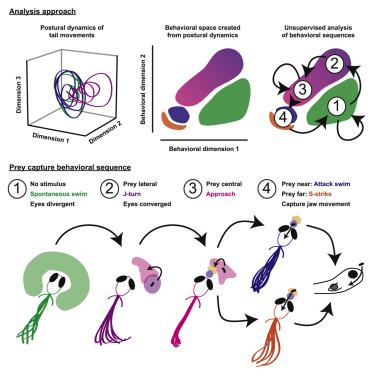当前位置:
X-MOL 学术
›
Curr. Biol.
›
论文详情
Our official English website, www.x-mol.net, welcomes your
feedback! (Note: you will need to create a separate account there.)
Deconstructing Hunting Behavior Reveals a Tightly Coupled Stimulus-Response Loop
Current Biology ( IF 8.1 ) Pub Date : 2019-12-19 , DOI: 10.1016/j.cub.2019.11.022 Duncan S Mearns 1 , Joseph C Donovan 2 , António M Fernandes 2 , Julia L Semmelhack 3 , Herwig Baier 2
Current Biology ( IF 8.1 ) Pub Date : 2019-12-19 , DOI: 10.1016/j.cub.2019.11.022 Duncan S Mearns 1 , Joseph C Donovan 2 , António M Fernandes 2 , Julia L Semmelhack 3 , Herwig Baier 2
Affiliation

|
Animal behavior often forms sequences, built from simple stereotyped actions and shaped by environmental cues. A comprehensive characterization of the interplay between an animal’s movements and its environment is necessary to understand the sensorimotor transformations performed by the brain. Here, we use unsupervised methods to study behavioral sequences in zebrafish larvae. We generate a map of swim bouts, revealing that fish modulate their tail movements along a continuum. During prey capture, larvae produce stereotyped sequences using a subset of bouts from a broader behavioral repertoire. These sequences exhibit low-order transition dynamics and immediately respond to changes in visual cues. Chaining of prey capture bouts is disrupted in visually impaired ( and ) mutants, and removing the prey stimulus during ongoing behavior in closed-loop virtual reality causes larvae to immediately abort the hunting sequence. These results suggest that the continuous integration of sensory information is necessary to structure the behavior. This stimulus-response loop serves to bring prey into the anterior dorsal visual field of the larvae. Fish then release a capture strike maneuver comprising a stereotyped jaw movement and tail movements fine-tuned to the distance of the prey. Fish with only one intact eye fail to correctly position the prey in the strike zone, but are able to produce the strike itself. Our analysis shows that short-term integration of binocular visual cues shapes the behavioral dynamics of hunting, thus uncovering the temporal organization of a goal-directed behavior in a vertebrate.
中文翻译:

解构狩猎行为揭示了紧密耦合的刺激响应循环
动物的行为通常形成序列,由简单的刻板行为构建并受到环境线索的影响。为了理解大脑执行的感觉运动转换,有必要全面表征动物运动与其环境之间的相互作用。在这里,我们使用无监督的方法来研究斑马鱼幼虫的行为序列。我们生成了一张游泳比赛的地图,揭示了鱼沿着连续体调节它们的尾巴运动。在捕获猎物的过程中,幼虫使用更广泛的行为库中的一部分回合来产生定型序列。这些序列表现出低阶过渡动力学,并立即响应视觉线索的变化。在视觉障碍(和)突变体中,猎物捕获回合的连锁被破坏,并且在闭环虚拟现实中持续行为期间消除猎物刺激会导致幼虫立即中止狩猎序列。这些结果表明,感官信息的持续整合对于构建行为是必要的。这种刺激-反应环路的作用是将猎物带入幼虫的前背侧视野。然后,鱼会释放捕获攻击机动,包括定型的下巴运动和根据猎物距离进行微调的尾部运动。只有一只完整眼睛的鱼无法将猎物正确定位在攻击区域,但能够自行发起攻击。我们的分析表明,双眼视觉线索的短期整合塑造了狩猎的行为动力学,从而揭示了脊椎动物目标导向行为的时间组织。
更新日期:2019-12-19
中文翻译:

解构狩猎行为揭示了紧密耦合的刺激响应循环
动物的行为通常形成序列,由简单的刻板行为构建并受到环境线索的影响。为了理解大脑执行的感觉运动转换,有必要全面表征动物运动与其环境之间的相互作用。在这里,我们使用无监督的方法来研究斑马鱼幼虫的行为序列。我们生成了一张游泳比赛的地图,揭示了鱼沿着连续体调节它们的尾巴运动。在捕获猎物的过程中,幼虫使用更广泛的行为库中的一部分回合来产生定型序列。这些序列表现出低阶过渡动力学,并立即响应视觉线索的变化。在视觉障碍(和)突变体中,猎物捕获回合的连锁被破坏,并且在闭环虚拟现实中持续行为期间消除猎物刺激会导致幼虫立即中止狩猎序列。这些结果表明,感官信息的持续整合对于构建行为是必要的。这种刺激-反应环路的作用是将猎物带入幼虫的前背侧视野。然后,鱼会释放捕获攻击机动,包括定型的下巴运动和根据猎物距离进行微调的尾部运动。只有一只完整眼睛的鱼无法将猎物正确定位在攻击区域,但能够自行发起攻击。我们的分析表明,双眼视觉线索的短期整合塑造了狩猎的行为动力学,从而揭示了脊椎动物目标导向行为的时间组织。











































 京公网安备 11010802027423号
京公网安备 11010802027423号